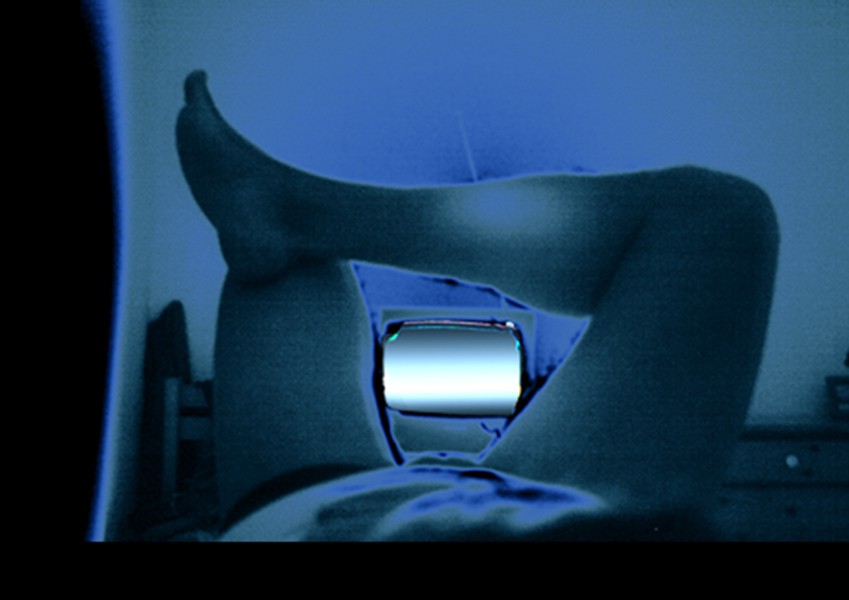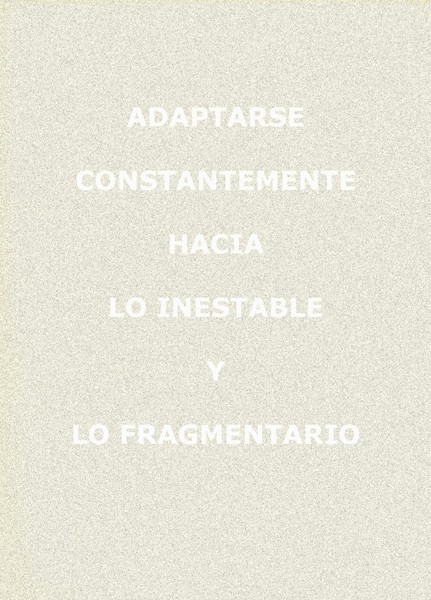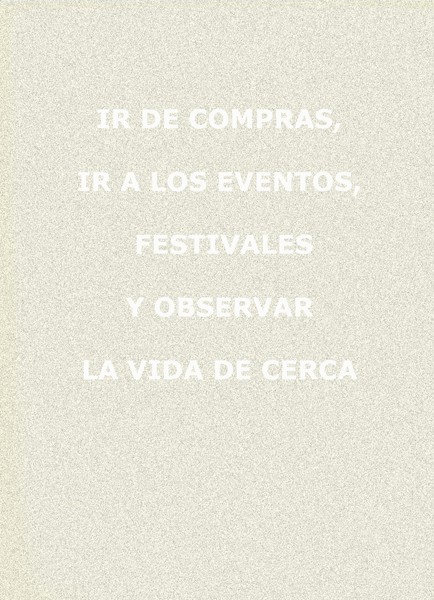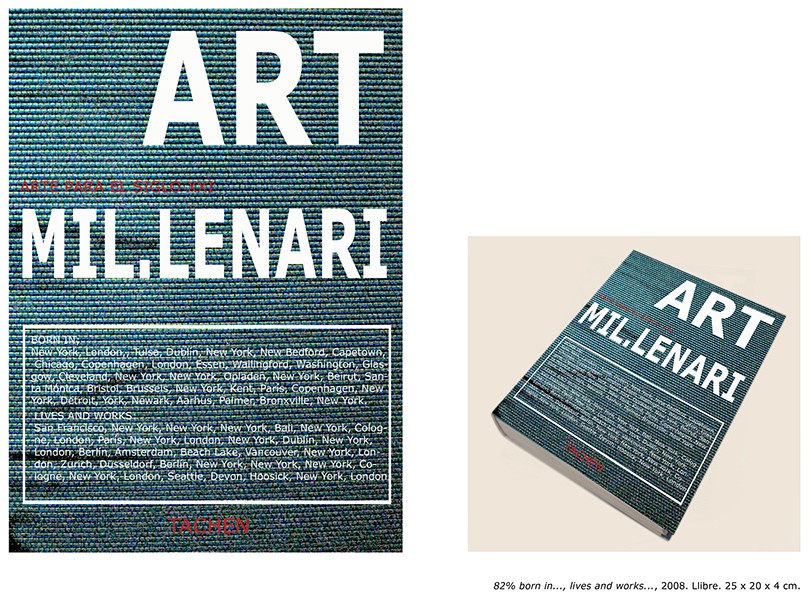










“Hey, Ho, Let's Go!”
“Hey, Ho, Let's Go!”. Mayo - Junio 2008
/ESP/
Desconectados, delante de un monitor de televisión, obligados a trascender y validar los sucesos que se van incorporando poco a poco en nuestra cabeza; intuimos que los acontecimientos - en forma de frames – caen y se amontonan subjetivamente bajo una apariencia estudiada y coherente. La información anexionada, sin embargo, no supera la mera catalogación de “producto” más o menos cohesionado. Pero sí, existe la voluntad de concretar globalmente una supraorganización legitimadora e interesada de la realidad económico-política e institucional.
Los mecanismos del poder bajo cualquier signo, con sus diferentes apreciaciones, reproducen la idea del espejismo verbal de la incontinencia controlada. Aquello que subyace como cierto en la formulación de la experiencia concreta-objetiva, posee sus orígenes en un enfoque clásico de estructura casi divina. El kitsch público, nacional-internacional, nos lleva a aceptar como naturales, aquellos signos que no van más allá de la propia subsistencia como especie. Las depredaciones culturales a que estamos sometidos, crean parámetros sociales de precariedad intelectual, sumisa y obediente, que no pasan el filtro de los organismos que el poder establece.
La urgencia, la fragmentariedad, la eficacia del espectáculo que las instituciones culturales promocionan, obliga a su fagocitación (canibalismo cultural propio) que provoca una adaptación constante de sus objetivos. Nada es desinteresado y por lo tanto, el mismo estamento supera su supervivencia. La idea de museo, tantas veces vendida como interés público, fascina por su estructura de cadáver turístico. El olor de maceración que produce la adaptación constante de estos cuerpos hacia su validación pública supone, no una estructura de intercambio, sino un deseo de clarificación de cuales son los intereses reales de fondo. La vida de estos mecanismos de orientación cultural no depende ya de ellos mismos. Su legitimidad no traspasa, en calidad de sujetos, su momificación.
La realidad es otra (de buenas intenciones todos vamos sobrados). La realidad es que se tendrá que transferir, si no se operan mecanismos ágiles de reorganización y actualización, a la gestión transparente de valores. Ya que el trasfondo siempre es económico-político (la opinión no nos parece simplista), podemos hablar de valores de mercado, de producto nacional y más tarde, de producto internacional. No de obra o de artistas, criterios, intenciones. Sí de validaciones, elecciones y accesos.
Si el mundo del arte y la vida, caminan en paralelo, y si los mecanismos de poder caminan en paralelo con los simulacros y el evento puntual, quizás deberíamos reconsiderar lo accidental, lo indebido o lo no pautado, como normas de juego. Los errores se pueden cometer pero no perpetuar, y si se perpetúan, deberían tener la posibilidad de una eficaz rectificación. No es posible acceder a la internacionalidad a través de actualizaciones milenarias de editorial, de enfoque rápido, ligero y económicamente rentables. Los estudios de captación deberían ir por otros derroteros menos epidérmicos que el del catálogo de Internet por entradas o el de “situaciones consolidadas”.
Pudiera ser que el pequeño capital privado, “aquellos que se la juegan con financiación privada”, permita un acceso más libre al artista con su tiempo. Claro que el artista debe ser un empresario de sí mismo, financiar la mayor parte de sus obras y esperar a que el público o su propia empresa, rescate u optimice la inversión. La vía privada sigue, de todos modos, intentando su subsistencia con su capital. Y volvemos a la inversión pública. Lo que supone para el artista y su público un difícil equilibrio. Dando supuestas muestras de excentricidad y banalidad, el artista genera o piensa generar, documentos mentales-visuales que intercambian conexiones válidas entre el público atento y la ficción pautada que nos ha tocado vivir; eso sí, cercanos al museo en la voluntad de su propia legitimación. De forma imprudente con su economía, pero fascinante en el fondo. ¿Porqué no? …
Las exposiciones hoy por hoy, destacan por no ser otra cosa que actos de fe compartidos, de difícil solución, si no existen otras alternativas públicas de financiamiento. No sólo el museo, que debiera tener otra orientación más arqueológica y constatar así su identidad real - el mismo MOMA sufre en el año 69 la petición de cierre por parte del “Art Action Group” -. Y si somos críticos, el fenómeno en la actualidad padece un cierto contagio, a no ser que el propio museo genere satélites cercanos a la actualización y transparencia.
/ENG/
Disconnected, before a television screen, forced to transcend and validate the events that enter our head little by little, we sense that the order of things - presented to us as frames - collapses into a heap despite its studied, coherent appearance. The information that is annexed in this way does not, however, go beyond merely cataloguing moreor less cohesive “product”. Nonetheless, the will does exist to give overall concrete form to a self-seeking supraorganisation that can legitimise the economic, political andinstitutional reality.
Power mechanisms, whatever their outward signs, with their different leanings, reproduce the idea of the verbal mirage of controlled incontinence. The origins of theunderlying truth in the formulation of concrete-objective experiences lie in a classical approach with a quasi-divine structure. Public, national-international kitsch leads us toaccept as natural those manifestations that seek nothing more than their own survival as a species. The cultural predations we suffer create social parameters of intellectual precariousness, submissive, obedient, that cannot pass through the filter of the bodies established by those who hold power.
The urgency, the fragmentary nature and the efficacy of the spectacle promoted by cultural institutions makes sure that it is gobbled up (cultural cannibalism), and this generatesthe constant adaptation of goals. Nothing is disinterested, and the institution itself ensures its own survival. The idea of the museum, so often passed off as being in the public interest, fascinates due to its structure as a tourism industry corpse. The smell of fermentation given off by the constant adaptation of these corpses in order to achieve public validation leads, not to a structure for exchanges, but to a desire to clarify what, deep down the real interests are. The survival of these mechanisms for cultural guidance no longer depends on they themselves. Their legitimacy goes no further than their status as subjects, their mummification.
The reality is quite different (we are all full of good intentions). The fact is that, unless effective mechanisms for reorganising and modernising are set in motion, we require a change towards a more transparent manipulation of criteria. Since economics and politics always lurk in the background (this opinion does not appear to us simplistic), we can speak of market values, of domestic product and, later, of international product, not of works or artists, criteria, intentions, but of validation, choice and access.
If the worlds of art and life run parallel to each other, and if power mechanisms go hand-in-hand with simulations and one-off events, then perhaps we should consider the accidental, the improper or the unscripted as the rules of the game. Errors can be made, but not perpetuated, and if they are perpetuated then the possibility for effective rectification should exist. It is not possible to achieve international status by publishing millenary updates, quick, easy and profitable “fixes”. Uptake studies should take less epidermal paths than that of the Internet catalogue for tickets or that of “established situations.”
It might be that small private capital, “those that run risks through private financing” allows freer access to artists and their time. Of course, artists must run their own businesses, financing most of their works and hoping that the public or their own businesses will enable their investment to be recouped or optimised. However this may be, the private sphere attempts to enable them and their capital to survive. And so we return to public investment. What it means for artists and their audiences is a difficult balance. Exhibiting supposed signs of eccentricity or banality, artists generate, or believe they generate, mental-visual documents that exchange valid connections between the attentivepublic and the scripted fiction that is our lot in life, though also close to the museum in terms of seeking their own legitimacy. Careless with their economy, but fascinatingat heart. Why not? …
Nowadays, exhibitions stand out as being nothing more than collective acts of faith, and it will be difficult to change this situation as long as alternatives to public financing do not exist. Not only museums, which should take a more archaeological approach in line with their true identity - in 1969, the Art Action Group even set up a petition to close nothing less than the MOMA, and if we can be critical today, this phenomenon may spread, unless the museum itself can generate satellites that can promote a more modern outlook and guarantee greater transparency.










